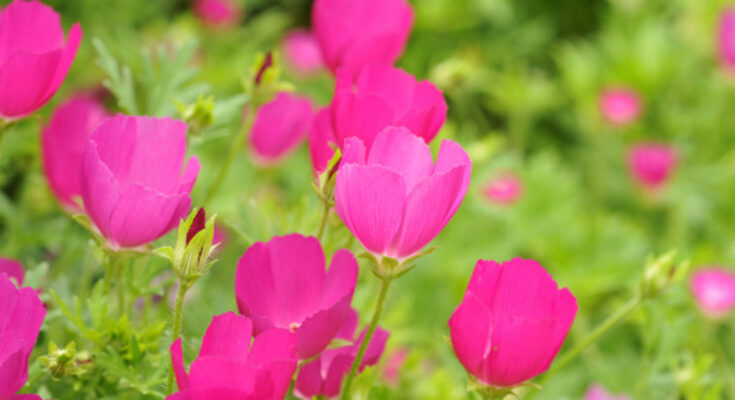Is Poppy Mallow The Right Flowering Ground Cover For Your Yard?
The right flowering ground cover can create effortless beauty in your yard, filling in a large area and delivering gorgeous blooms every year, often without the maintenance required of annual flower beds or traditional lawns. The key is to find something that fills in quickly enough that it won’t get choked out by weeds before it gets established, but also isn’t so aggressive that it takes over your garden. Purple poppy mallow (Callirhoe involucrata) is a native flowering perennial that checks both boxes.
If you’ve got a dry, sunny area that you want to fill in quickly, purple poppy mallow is an excellent drought tolerant ground cover you can easily grow. It thrives in dry, gritty soil and puts out vibrant magenta or purple cup-shaped flowers all summer long. Those saturated blooms stand out easily against the bright green foliage to create an eye-catching display.
Each individual plant reaches only about 6 to 12 inches tall but can spread to form a mat about 3 feet wide. But it spreads by seed, not rhizomes or vines, so it won’t keep spreading to take over your entire yard. Meanwhile, letting it go to seed will help it fill in a large area quickly if you want it to. With that said, it’s difficult to remove once established thanks to its long taproot, so you need to be diligent about pulling up sprouts that emerge where you don’t want them. Fortunately, the seeds typically fall near the plant, so any stray sprouts will generally be concentrated near the edges of your poppy mallow bed.
Benefits of planting a purple poppy mallow ground cover
Native throughout much of the central United States and Mexico, purple poppy mallow thrives in USDA hardiness zones 4 through 8. With a taproot that can grow up to 2 meters (about 6.5 feet) deep, purple poppy mallow is exceptionally tolerant of both drought and poor soil. In the wild, it’s found in dry, rocky areas that get full sun. If that sounds like your yard, this hardy perennial would make a great ground cover choice that requires little to no watering once established. But it will also do fine in loamy or clay soils as long as you let the soil dry out between watering.
In addition to being drought tolerant and thriving in poor soil, its growth habit makes it a great ground cover. The stems grow horizontally, close to the ground, so a single plant can fill in a 3-foot area by itself. Once established, it will bloom repeatedly from about March through August. While it already blooms continuously through such a long growing season, you can encourage even more prolific blooming by periodically removing flowers as they start to fade.
That prolific blooming also means this native flowering ground cover will fill your yard with bees and other pollinators. It’s a nectar source for native bees and butterflies as well as a host plant for the gray hairstreak butterfly. So, if you want a low-maintenance ground cover that also turns your garden into a pollinator paradise, purple poppy mallow will be a great fit.
Downsides of purple poppy mallow to consider before planting
While the showy blooms and drought tolerance make purple poppy mallow a gorgeous ground cover choice in dry, sunny yards, there are some tradeoffs worth noting. The biggest one is that it can go dormant in late summer. It will green up again with rain, but this trait may make it a poor choice for gardeners who want a consistent green ground cover through the warmer seasons. You might be able to prevent dormancy by removing flowers before they go to seed. Though, if you’re relying on poppy mallow’s self-seeding habit to fill in quickly, this would prevent it from seeding the area.
Another option is to create a mixed ground cover with poppy mallow and late summer bloomers like sulphur flower (Eriogonum umbellatum) or native sage (Salvia greggi). This will not only extend the bloom season, but adding late-blooming flowers to your garden also provides an important food source for pollinators at a time when most of their favorite nectar flowers are going dormant or no longer producing new blooms.
One more downside to consider is that the deep root that makes poppy mallow so drought tolerant also makes it hard to remove if it gets into an unintended area. While it’s not an aggressive spreader, the self-seeder may occasionally sprout in adjacent areas where you don’t want it. You’ll need to be diligent about removing those sprouts early because they’ll be hard to pull once that taproot develops.



